Mad Libs Worksheets
About These 15 Worksheets
Mad Libs worksheets are a popular form of word game or educational exercise designed to teach and reinforce knowledge of parts of speech in a fun and engaging way. Originating in the United States in the 1950s, Mad Libs have become a staple in language education and entertainment.
Mad Libs are created by writing a short story or a series of sentences with key words removed and replaced with blanks. Each blank is labeled with the part of speech that should fill it, such as noun, verb, adjective, adverb, etc. Players are asked to provide words corresponding to these parts of speech without knowing the context of the story. Once all the blanks are filled, the story is read aloud, often resulting in humorous or nonsensical narratives due to the unpredictable word choices.
Mad Libs worksheets offer a unique blend of education and entertainment. By turning the process of learning grammar into a game, they make the subject approachable and engaging for students of all ages. The versatility of these worksheets means they can be adapted for a wide range of educational needs and learning levels, making them an invaluable tool in language education. Their use not only strengthens a student’s grasp of grammar but also enhances creative thinking, vocabulary, and overall language skills.
Types of Exercises
Basic Parts of Speech Practice – These worksheets focus on fundamental parts of speech like nouns, verbs, adjectives, and adverbs. Players provide words that fit these categories to complete the sentences. Some Mad Libs target more complex grammatical concepts like tenses, plural forms, prepositions, conjunctions, and interjections.
Themed Stories – These worksheets are based on specific themes like holidays, historical events, or popular culture. They often include vocabulary relevant to the theme.
Dialogue Creation – In this type, players fill in the blanks in a dialogue between characters, practicing direct speech and conversational language. Some Mad Libs are designed to form a coherent, albeit unpredictable, story. This type requires players to think about story structure and elements.
Poetry and Rhyme – These worksheets focus on creating poems or songs, where players must consider rhyme and rhythm in their word choices.
Educational Benefits of Mad Libs
Grammar Reinforcement – By constantly identifying and supplying various parts of speech, students reinforce their understanding of grammar rules.
Vocabulary Expansion – Regular practice with different themes and contexts exposes students to a wide range of vocabulary.
Creative Thinking and Writing – Mad Libs encourage creativity, as students often come up with unique and imaginative word choices to fill the blanks.
Understanding Context – Since the words are chosen without context, the resulting stories help illustrate how word choice can dramatically alter meaning, enhancing comprehension skills.
Language Flexibility – Students learn to play with language, understanding how different words can fit into sentences while altering the tone or meaning.
Engagement and Motivation – The fun and interactive nature of Mad Libs make learning grammar less intimidating and more enjoyable, which can motivate reluctant learners.
Collaborative Learning – Often done in groups, Mad Libs can foster teamwork and communication skills as students negotiate word choices.
Cognitive Skills – The exercise requires memory recall, vocabulary access, and a basic understanding of syntax, all of which are essential cognitive skills in language learning.
Adaptability for Different Levels – Mad Libs can be easily adapted to suit various learning levels, from beginners learning basic nouns and verbs to advanced students tackling complex grammatical structures.
Feedback and Correction – Teachers can use the outcomes of Mad Libs exercises to identify areas of misunderstanding or confusion in students’ grammatical knowledge.















